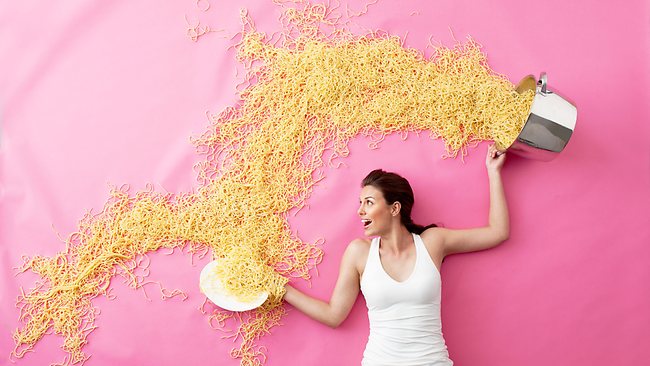Faster pasta for weeknight meals
ONLY a passionate Italian chef could answer with a non sequitur when asked to settle one of the culinary world's age-old chestnuts; dried or fresh pasta?

ONLY a passionate, intuitive Italian chef could answer with a non sequitur when asked to settle one of the culinary world's age-old chestnuts; dried or fresh pasta?
"Well, if you love dried pasta then dried pasta is best," says Joel Valvasori, the executive chef at Perth newbie Lalla Rookh Bar and Eating House.
"But if you like the mouth feel of freshly made pasta then that's best too. They're two entirely different things.
"Fresh pasta is made with eggs, dried pasta is made with semolina flour and water.
"The thing that's important is getting the right sauce to match the pasta." OK, that's settled then. Not.
Hmm, if dried pasta is equally good then why do chefs, like Joel and Guy Grossi, spend hours every day in their restaurant kitchens kneading, rolling and resting several kilos of pasta dough to make the classic Italian dishes for their adoring customers?
"Simple," says Joel. "I just love making pasta. It's all part of the ritual. Making it, then choosing the right sauce to go with it, then sitting down with the family to eat together is what it's all about. The ritual."
Guy Grossi, of Melbourne's quintessential Italian restaurant Grossi Florentino, agrees. It's the customers at his three eateries housed in the historic Bourke St building that get to enjoy the fruits of his ritual. He offers around 15 different pasta dishes and the slippery pappardelle, shiny lasagne sheets and silky tortellini are all made on the premises.
To Joel and Guy, it's as simple as grabbing four eggs, adding 2 1/2 cups of double-zero flour, some salt and then mixing and kneading until it feels just right.
"It's a feeling thing," says Joel. "To do it properly takes around 2 1/2 hours."
Sounds like it's an Italian thing. But both chefs say the average cook can rustle up a restaurant-quality pasta meal in less than 15 minutes with a good store-bought dried pasta.
GET SAUCY
TO prove the old saying that if you can boil water you can make pasta, they say all that's involved is adding a home-made sauce. And that's where the imagination steps in.
Simply choose your base: oil, tomato or cream. And work up from there to create an aglio e olio, a puttanesca or a carbonara. Go the basil and pine nut route and hey presto, you've got pesto.
Fry some breadcrumbs in oil and add some anchovies, and you've got spaghetti alla carrettiera.
But before you roll up your sleeves and make like a true Italian chef, here's a word of warning.
Whatever accompaniment you choose to round out your choice of pasta, now the world's most popular food, you must promise the maestros three things: never throw chunks of spaghetti at a wall, never break it into bits to cook, and never, not ever, insult your pasta by adding oil to the cooking water.
Both Joel and Guy are well qualified to set these important rules. Having spent their childhoods - on opposite sides of the country - sitting under the kitchen table watching their mama and nonna making fettucine, rigatoni and lasagne sheets, they know their bigoli from bucatini.
Here's their definitive guide to preparing the food that, when coupled with bolognese, calls Australians to the table more often than any other.
---
* FACT OR FICTION *
COOKING WATER NEEDS TO BE SALTED
Joel: Fact. "We use a Sicilian sea salt. It's mellow in flavour. The water needs to be well seasoned because you only get one chance to get salt into the pasta. There's no point in adding it after the pasta is cooked, the pasta won't absorb it and you'll end up with a bland dish."
Guy: Fact. "Yes, definitely. And the water needs to be on a rolling boil when you add the pasta. And don't forget to stir the pasta well when you add it. That will stop it sticking."
ADD 1 TBSP OF OIL TO THE WATER
Joel: Fiction. "No, there's no need. All it does is make the pasta slippery and the sauce won't stick. When you add the pasta to the water, stir it to stop it sticking, it's when the starch granules on the surface of the pasta swell up to their maximum volume and then pop and the starch rushes out, and, for a brief time, the pasta's surface is sticky with this starch. That's why you stir."
Guy: Fiction. "I think the oil idea comes from thinking that oil will stop it sticking together. Just stir it."
YOU CAN ADD ANY SAUCE TO ANY PASTA
Joel: Fiction. "A pasta like fazzoletti (handkerchief pasta) must have a slow, braised sauce to go with it. The way the pasta carries the sauce helps create the pleasure on the palate when the pasta crosses your tongue.
A pasta like orecchiette goes well with small vegies such as peas or broccolini florets where the shell can hold them. They just go together."
Guy: Fiction. "Well, certain things just go together like a marinara with spaghettini or linguine. You'd never put a little pasta like risoni in anything but a soup. Penne or macaroni and pappardelle work well with ragu. Use delicate noodles for delicate sauces while heartier noodles are for heartier sauces."
YOU SHOULD RINSE THE PASTA AFTER COOKING
Joel: Fiction. "That removes the starch that helps the sauce stick to the pasta."
Guy: Fiction. "Never wash it in water. That's just plain wrong. Some people believe that rinsing it in cold water stops it from continuing to cook, but you can always take it off the boil just a bit earlier if you are worried about overcooking it."
THROW IT AGAINST THE WALL TO TEST WHETHER IT IS AL DENTE
Joel: Fiction. "All you get is a messy wall. Al dente (to the tooth) means different things to different people. My family like it cooked, not al dente. I pull it out and try a piece.
"If it has a stickiness and is soft all through, it is cooked. If it has a white dot in the middle it is not cooked. Some people like it like that."
Guy: Fiction: "I touch the pasta and when it is cooked it has a feel to it. I like it more al dente so always cook it a little bit firm. The mouthfeel changes when you have a bit of a bite to it."
EAT PASTA WITH A FORK
Joel: Fact. "It can only be eaten with a fork. No spoon required. Twirl spaghetti with the fork and move it to the side of the bowl. Yes, it must be eaten in a bowl."
Guy: Fact. "There's a couple of schools of thought on this. Traditionally, the fork is enough but a lot of people like to have a spoon as well. Never use a knife."
PASTA SAUCES CAN BE MADE IN LESS THAN 15 MINUTES
Joel: Fact. "We do a great tagliolini. Take a handful of broad beans and fry them in oil with some chopped garlic and chilli.
"Deglaze the pan with white wine and maybe some chicken stock. Cook for a few minutes and add a knob of butter, throw in the tagliolini and then heat through.
"Top with finely grated bottarga di tonno (air dried roe of the tuna) or Australian-made mullet roe."
Guy: Fact. "Of course. Some of the best pasta dishes are the most simple."
"This one is great for summer: Saute some chopped onion and garlic, and some fresh peas and herbs, such as sage or basil, some pasta water from the cooked pasta. Add penne and top with shaved parmesan."
---
ZUCCHINI, PEA AND MINT SPAGHETTI
- Serves 4-6
- Preparation time: 10 minutes
- Cooking time: 15 minutes
- Skills: Basic
**
1 large lemon
4 slices ciabatta bread
250g dried spaghetti pasta
2 tbsp olive oil
2 large zucchini, grated
2 garlic cloves, crushed
3/4 cup frozen baby peas
1/4 cup extra-virgin olive oil
1/4 cup chopped fresh mint leaves
Shaved parmesan cheese, to serve
**
Finely grate and juice lemon. Roughly tear ciabatta.
Cook pasta in a large saucepan of boiling salted water, following packet directions, until tender. Drain.
Meanwhile, heat olive oil in a large frying pan over medium-high heat. Add bread. Cook, stirring, for 3-4 minutes or until golden brown.
Transfer to a bowl.
Add zucchini and garlic to pan. Cook, stirring, for 3 minutes or until zucchini starts to soften. Add peas. Cook, stirring occasionally, for 3-5 minutes or until peas are tender. Add pasta, lemon rind, lemon juice, extra-virgin olive oil and mint. Cook, tossing, for 2 minutes or until combined and heated through. Season with salt and pepper. Sprinkle with bread and parmesan. Serve.
--
Recipe: Kim Coverdale from Super Food Ideas
Picture: Ben Dearnley



